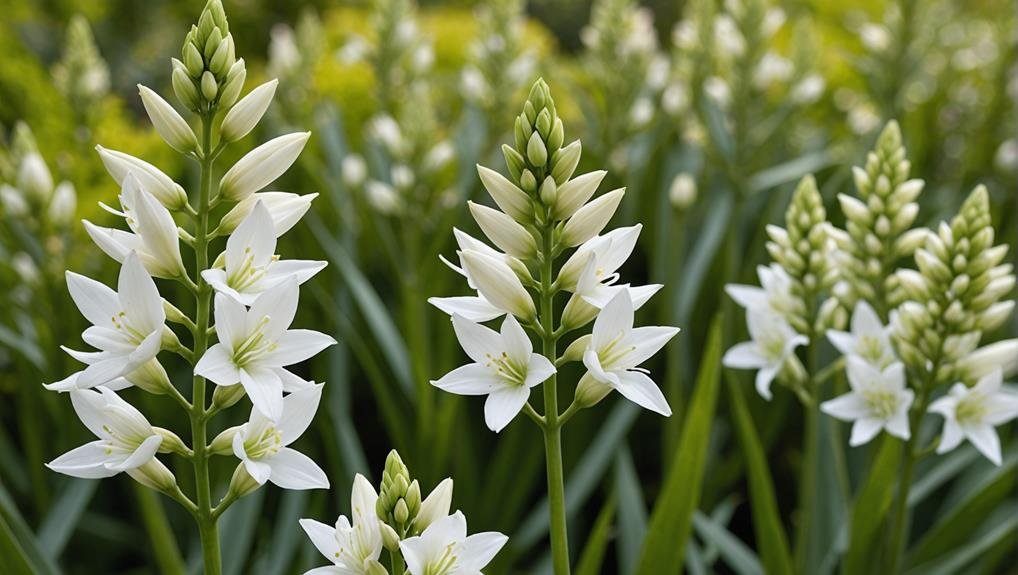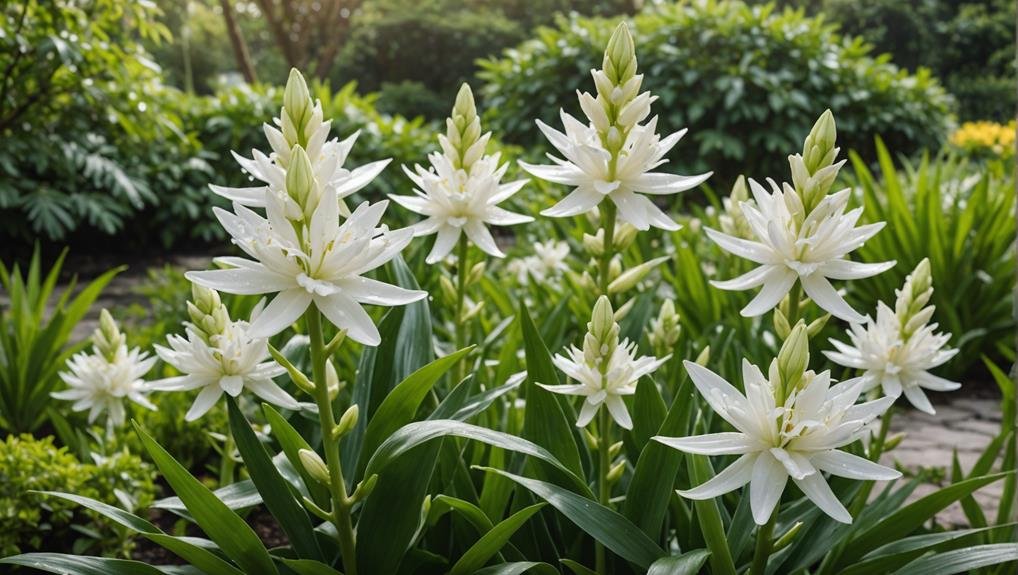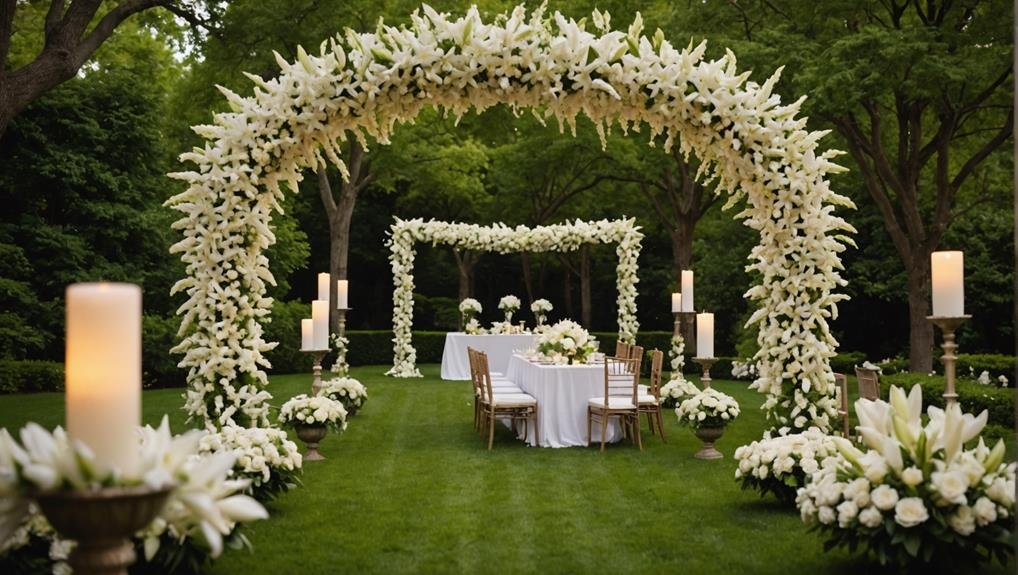When considering the ideal floral arrangement for an elegant wedding, the Tuberose stands out with its creamy-white tubular petals and subtle pink blush, symbolizing purity and allure. This enchanting flower, originally cultivated by the Aztecs and often referred to as 'bone flowers,' is renowned for its intoxicating nighttime fragrance, evoking an air of romance and sophistication. With a vase life extending up to 14 days under proper care, Tuberose not only enhances bridal bouquets but also adds a timeless charm to wedding décor. Discover more about its unique qualities and cultural significance as we explore its role in creating unforgettable nuptial experiences.
Flower Overview

Tuberoses, originally cultivated by the Aztecs and known as 'bone flowers,' are renowned for their intoxicating nighttime scent and rich historical significance. These flowers have long been cherished for their ability to evoke romance and allure, making them a popular choice for wedding bouquets. Their heavy, sweet fragrance enhances the ambiance of any ceremony, especially those held in the evening when the scent is most potent. The Victorian Language of Flowers even associated tuberoses with dangerous pleasures, adding an element of mystique to their use.
Incorporating tuberoses into wedding bouquets can elevate the floral arrangement, providing a touch of elegance and sophistication. Popular cultivars such as 'The Pearl' and the taller Mexican Single type offer a variety of options to suit different wedding themes and styles. Their lush, white blooms stand out beautifully against greenery and other floral elements, making them versatile additions to any bouquet.
To cultivate tuberoses successfully, they require rich, well-drained soil and ample sunlight. They need a growing season of at least four months to bloom, typically between July and October. This guarantees that they are in prime condition for use in wedding arrangements, adding timeless beauty to the special day.
Physical Description
Characterized by glossy, creamy-white tubular blooms with a delicate pink tint on the outer petals, the tuberose offers both visual appeal and a breathtaking scent. This combination has made tuberose a favored choice for weddings and floral arrangements.
The physical description of tuberose flowers reveals an elegant structure; the blooms are tubular and arranged along the length of the stem, creating a striking vertical display. Each stem of tuberose typically ranges from 60 to 80 centimeters in length, providing ample height for various floral designs.
The flowers are often sold in bunches of five, with the best selection being stems where 70% to 80% of the lower florets are just starting to open. This guarantees maximum freshness and a strong, sweet fragrance, indicative of their quality.
The glossy texture of the blooms contributes to their durability, giving them a vase life of 10 to 14 days with proper care. Tuberose is commercially grown in Australia, mainly available from late summer to autumn, making it a perfect choice for late-season weddings and events.
This flower's physical attributes, combined with its captivating scent, make it a sought-after addition to any bridal bouquet.
Available Colour Varieties

While tuberose flowers are mainly known for their waxy, creamy-white blooms accented with a delicate pink blush, their subtle variations in hue can add an exquisite touch to any floral arrangement. These available colour varieties mostly range from pure white to those with a gentle pink tint, creating a classic and elegant aesthetic that is particularly favored for weddings and special events.
The pristine appearance of tuberose blooms, characterized by their tubular structure and soft coloration, enhances their appeal. This subtle color palette allows them to blend seamlessly into various floral themes, offering versatility and sophistication. The waxy texture of the petals further accentuates their beauty, giving them a luxurious and timeless quality.
In Australia, tuberose flowers are commercially grown and are typically available from late summer to autumn. This seasonal availability makes them an excellent choice for late-season weddings and occasions. To ensure a continuous supply, tuberose flowers may also be imported, thereby extending their availability beyond their natural growing season. This guarantees that the elegant and understated charm of tuberose flowers can be enjoyed year-round, providing floral designers with a reliable option for creating stunning arrangements.
Latin Name and Taxonomy
Belonging to the Asparagaceae family, the tuberose is botanically known as Polianthes tuberosa and is celebrated for its enchanting fragrance and elegant blooms. This perennial plant features long, narrow leaves and tall, fragrant flowers that make it a popular choice for weddings and other special occasions.
Polianthes tuberosa is part of the Polianthes genus, which comprises approximately 17 species. Among these, tuberosa stands out due to its highly regarded scent. The flowers of Polianthes tuberosa are tubular and waxy white, often exhibiting a delicate pink blush on the outer petals, adding a romantic touch to floral arrangements.
Taxonomically, tuberoses fall under the order Asparagales, which includes a diverse range of ornamental and economically significant plants. This classification places them alongside other well-known members of the Asparagaceae family. The genus name Polianthes is derived from Greek, meaning 'many flowers,' which aptly describes the plant's prolific blooming nature.
Understanding the Latin name and taxonomy of Polianthes tuberosa not only highlights its botanical significance but also underscores its enduring appeal in floral design. The combination of its aesthetic beauty and alluring fragrance makes the tuberose a timeless favorite in the world of wedding flowers.
Geographical Origins

Tuberose, known for its intoxicating fragrance, originally hails from Mexico, where it was cultivated by the Aztecs and referred to as 'bone flowers.' This exotic bloom was introduced to Europe during the Spanish conquest and quickly garnered admiration, especially during the reign of Louis XIV in France. Its rich, heady scent became synonymous with luxury and opulence, cementing its place in European horticulture and courtly life.
The Victorian era further solidified tuberose's enigmatic reputation, as it became associated with 'dangerous pleasures' in the Language of Flowers. This symbolism added an air of mystery and allure, making tuberose a popular choice in both romantic and ceremonial contexts.
Below is a table outlining the key geographical origins and historical spread of tuberose:
| Region | Historical Context |
|---|---|
| Mexico | Cultivated by the Aztecs, known as 'bone flowers.' |
| Spain | Spread to Europe during the Spanish conquest. |
| France | Gained favor during the reign of Louis XIV. |
| United Kingdom | Incorporated into the Victorian Language of Flowers. |
| Worldwide | Popular in wedding bouquets and leis globally. |
Understanding the geographical origins of tuberose not only highlights its historical significance but also underscores its enduring appeal in modern floral arrangements.
Season Availability
The historical allure of tuberose is complemented by its seasonal availability, mainly from late summer to autumn in Australia. This period is ideal for late-season weddings and events, offering a unique charm and aromatic presence. During these months, tuberose is at its peak, providing florists and event planners with the freshest and highest quality blooms.
The following points highlight the key aspects of tuberose availability:
- Late Summer Blooms: The tuberose's peak season guarantees its availability for events scheduled from late summer through autumn.
- Imported Options: Outside the usual growing period, tuberose can still be obtained through imports, maintaining its presence in the floral market.
- Optimal Freshness: When purchasing, choose stems with 70% to 80% of the lower florets just starting to open for the best freshness and longevity.
Tuberose's vase life typically ranges from 10 to 14 days with proper care, making it a reliable choice for extended displays. Its seasonal availability from late summer to autumn ensures that it remains a delightful and practical option for weddings and other significant events during these months. This guarantees its continual appeal and integration in floral arrangements, providing both beauty and fragrance.
Growing Conditions

Tuberoses flourish in conditions that provide abundant sunlight, fertile, well-aerated soil, and a warm growing season of at least four months. These flowers are ideally suited for USDA hardiness zones 8 through 11, and with heavy winter mulching, they can potentially survive in zone 7. The growing season typically spans from July to October, making tuberoses a summer staple in suitable climates.
To promote ideal growth, tuberoses should be planted 6 inches apart with 2 inches of soil covering the rhizomes. The soil must be rich in nutrients and well-aerated to prevent waterlogging, which can lead to root rot. In northern climates, where winters are harsher, tuberoses may need to be dug up and stored indoors during autumn to protect them from the cold.
Below is a summary of the key growing conditions for tuberoses:
| Condition | Details |
|---|---|
| Sunlight | Full sun |
| Soil | Fertile, well-aerated |
| Planting Depth | 6 inches apart, 2 inches of soil covering |
| Hardiness Zones | 8-11 (possible in zone 7 with heavy mulching) |
| Growing Season | At least four months (July to October) |
Planting new rhizomes each spring is necessary, as tuberoses flower only once. This guarantees continuous blooming and vibrant displays year after year.
Cultural Significance
Beyond their specific growing conditions, tuberoses hold a rich cultural significance that spans centuries and civilizations. Originally cultivated by the Aztecs, these flowers were known as 'bone flowers' due to their striking white, waxy appearance. Their importance in Aztec culture underscores their long-standing allure and historical depth.
In the Victorian Language of Flowers, tuberoses were associated with dangerous pleasures, adding a layer of intrigue to their symbolism. This association reflects the deep, intoxicating scent of tuberoses, which has captivated many throughout history. Despite their occasional use in funerals, tuberoses have consistently been valued for their strong fragrance and unique beauty.
The heavy nighttime scent of tuberoses makes them ideal for creating a romantic and aromatic atmosphere, further cementing their cultural significance.
These flowers have been used in various cultural ceremonies and traditions, such as:
- Aztec rituals: Tuberoses were integral to various Aztec ceremonies, reflecting their sacred status.
- Victorian bouquets: The flowers' association with dangerous pleasures made them a popular yet mysterious choice.
- Modern floral designs: Their unique appearance and fragrance have revived their popularity in contemporary arrangements.
Tuberoses continue to enchant and inspire, embodying a rich tapestry of cultural significance.
Typical Use in Weddings

In wedding arrangements, tuberose is favored for its elegant stems, fragrant blooms, and symbolic associations with purity and peace. This popular flower is often chosen for bridal bouquets, enhancing the overall aesthetic with its delicate appearance and enchanting fragrance. Its long-lasting vase life, extending up to 14 days with proper care, guarantees that tuberose maintains its beauty throughout wedding celebrations.
Tuberose's symbolic connotations further elevate its status in wedding floral arrangements. The flower is traditionally associated with warding off the evil eye, adding a layer of meaningful protection to the joyous event. Brides often select tuberose for its connotations of innocence, making it a fitting representation of new beginnings and the sanctity of marriage.
Moreover, tuberose is versatile in its application within wedding decor. Florists frequently wire individual blooms into intricate designs, incorporating them into various accessories such as boutonnieres, corsages, and hairpieces. This adaptability makes tuberose a popular choice for those looking to add a touch of elegance to multiple facets of the ceremony and reception.
Alternative Flower Types
When considering alternative flower types for wedding arrangements, several options stand out for their unique qualities and symbolic meanings. Tuberose, with its delicate white blooms and intense fragrance, offers a compelling substitute to traditional flowers such as roses or lilies. Its symbolism of purity, peace, and innocence lends a special significance to wedding bouquets and decorations.
Floral designers often consider these substitutes for their distinct advantages:
- Lifespan: Tuberose is known for its long-lasting nature, making it ideal for events that span several days.
- Elegance: The tall stems and graceful appearance of tuberose make it a popular choice for creating stunning centerpieces and ceremony arrangements.
- Fragrance: The intense, sweet scent of tuberose can enhance the sensory experience of any wedding.
In addition to its aesthetic and symbolic attributes, tuberose is versatile and can be paired with various other flowers and greenery to create diverse and enchanting floral displays. Its ability to remain fresh and vibrant for extended periods guarantees that wedding arrangements maintain their beauty throughout the event.
For these reasons, tuberose continues to be a favored option among floral designers looking to craft memorable and meaningful wedding decor.
